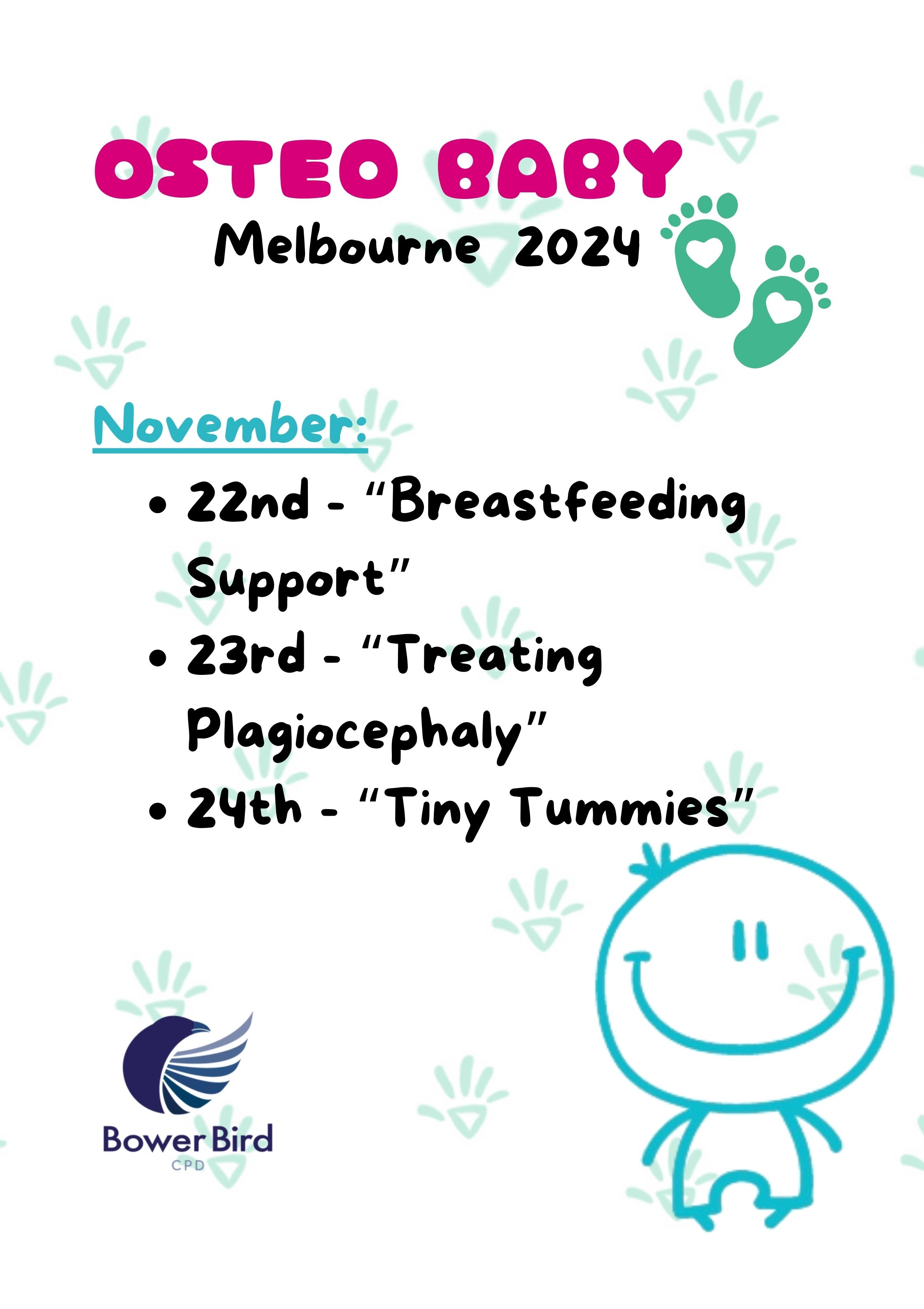
10 Apr Osteo Baby series – Melbourne 2024
Excited and honored for this opportunity to bring my experience to Australia, specifically to Melbourne, in November 2024!
In collaboration with Bower Bird, we have created three one-day, single-topic courses on highly relevant subjects: “Breastfeeding Support”, “Treating Plagiocephaly” and “Tiny Tummies”.
During these sessions, we will delve deeply into each topic in light of recent research, and at the end of each day, participants will have the chance to apply what they’ve learned through a hands-on clinical session with young patients. I can’t wait to be there!
Want more information? Click on the course title to be directed to the Bower Bird website, where you’ll find the detailed program and registration form.
C. M. Luisa Miraglia D.O.P.
Breastfeeding support (22/11/24)
Learning Objectives
- Gain an overview of common breastfeeding issues such as latch difficulties, milk supply concerns, nipple pain.
- Examine the anatomy, physiology and endocrinology relating to lactation.
- Understand the mechanics of milk production and the ‘let-down’ reflex.
- Explore the relationship between musculoskeletal issues and breastfeeding mechanics.
- Learn to conduct a comprehensive assessment of breastfeeding dynamics and related MSK dysfunction including for baby’s skull, cervical spine, shoulder dystocia, breathing dynamics, pelvic mechanics and more.
- Learn appropriate gentle osteopathic techniques including soft tissue manipulation, mobilization and cranial techniques.
- Understand the importance of posture to lactation and how to correct postural imbalances.
- Discuss torticollis and its effect on breastfeeding.
- Develop effective communication strategies to provide empathetic support and guidance for parents.
- Build an interdisciplinary team with lactation consultants, midwives, and other healthcare providers.
Treating plagiocephaly (23/11/24)
Learning Objectives

- Explore the types, causes and risk-factors of plagiocephaly.
- Learn the diagnostic criteria and techniques for treating plagiocephaly.
- Recognise the severity and progression of cranial deformities.
- Improve your history taking procedure.
- Understand how Cranial Osteopathy can be applied including;
- Common Cranial Osteopathic techniques
- Gentle mobilisations for cranial alignment
- Balancing the cranial rhythm
- Apply a whole-body approach by addressing musculoskeletal imbalances and considering the impact of soft tissue tension.
- Develop individualized patient care plans with tailored treatments considering age and severity of presentation.
- Build your interdisciplinary team with paediatricians, physiotherapists, and other healthcare professionals to co-ordinate a comprehensive treatment plan.
- Understand the red-flags, contraindications and precautions necessary to ensure safe and effective practices.
- Learn to assess patients’ progress, track changes in cranial shape and symmetry and, adjust treatment plans as needed.
- Communicate effectively with patients and caregivers to explain treatment goals and expectations.
- Educate families and provide guidance on home exercises and positioning techniques.
- Prepare for longer-term management by anticipating potential challenges and setbacks, and promoting continued cranial health and development.
- Evaluate the efficacy and future of osteopathic intervention, including recent advances and areas for further research/investigation.
Tiny Tummies -Treat underlying issues in baby’s digestive system (24/11/24)
Learning Objectives
 Understand infant colic, constipation and reflux, their causes, and how they affect little ones (and their parents).
Understand infant colic, constipation and reflux, their causes, and how they affect little ones (and their parents).- Learn a wide variety of assessment tools for babies including;
- Observation of behaviour, posture, feeding patterns and symptoms,
- Palpation to assess muscle tone, spinal mobility, cranial structures and restriction in the diaphragm, thoracic spine and abdomen,
- Tension and mobility of the gastrointestinal system,
- Evaluation of pelvic floor muscle tone and co-ordination,
- Evaluation of cranial/cervical mobility to ensure optimal nerve function,
- and more…
- Understand real-world applications via cased-based learning.
- Discover gentle cranial osteopathic techniques to address cranial restrictions, optimize cerebrospinal fluid dynamics, and enhance vagal tone and digestive function.
- Learn infant-specific soft tissue techniques to release tension in the diaphragm, abdominal organs, and pelvic floor, and improve respiratory function.
- Restore proper nerve function and alleviate tension via mobilization of the spinal segments.
- Learn visceral manipulation techniques to improve mobility and function of the intestines.
- Enhance baby’s parasympathetic tone and facilitate relaxation of the pelvic floor.





No Comments